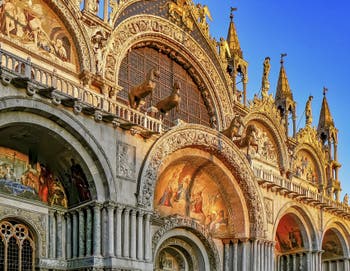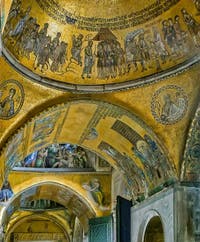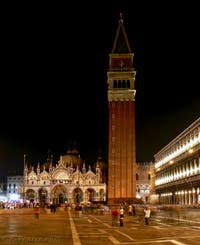History Important dates | Politics | Navy | Love | Wars | Religion | Scuole | Ghetto | Printing
Religion Paolo Sarpi |
History of Religion in Venice

The facade of the Basilica Saint Mark the Evangelist is the patron saint of Venice, which is also under the protection of the Virgin Mary and her son, Jesus Christ.
Queen of the Seas and the Heavens!
Venice was officially founded in March 421, more precisely on 25 March, the day of the Annunciation of the birth of Christ.It is a city born from the sea, a Christian Venus born after the fall of the Roman Empire caused by barbarian hordes.
Its birth seemed to promise a new era in which the pagan and Christian visions of the world would unite harmoniously in a single free and sovereign person.
Venice, majestic Venus, Queen of the Seas and the Skies!
The Myth of Catholic Venice

Mosaics in the atrium Such is the origin and originality of the myth of Catholic Venice, whose Doge set sail aboard the magnificent Bucentaure to celebrate his marriage to the sea, throwing a gold ring into the water on Ascension Day.
This symbolic wedding was intended to remind people of Venice's supremacy and its close ties with its maritime empire.
There are many paintings depicting the Doge kneeling before the Virgin Mary and the baby Jesus.
The numerous religious buildings: churches richly decorated with paintings by the greatest masters, convents and scuole attest to the importance of religious practice and the presence and activity of monastic orders in Venice.
Temporal and Spiritual: The Venetian Melting Pot

Basilica and Bell Tower The Rialto was the seat of commerce and economy, while St. Mark's Square was the place where devotion to the patron saint and political power coexisted.
It brings together St. Mark's Basilica, the Bell Tower with its bells, and the Doge's Palace, where the Doge is elected and resides.
This neighbourhood perfectly reflects the proximity of the temporal and spiritual in Venice.
The Patriarch of Venice was not appointed by the Vatican, but chosen by the Venetians, and religious festivals were always combined with the pomp and circumstance of republican political power.
Venice fiercely defended its economic interests and political independence throughout its history.
Its politics, a mixture of devotion to the homeland and Catholic faith, also sought to prevent any encroachment of spiritual power on temporal power that might threaten the sovereignty of the Republic.
This original synthesis of convictions, which established and defended the separation of political and religious power, gave it the strength and courage to assert itself against foreign sovereigns and the Vatican.
Religion Paolo Sarpi |
History Important dates | Politics | Navy | Love | Wars | Religion | Scuole | Ghetto | Printing
Back to Top of Page

